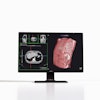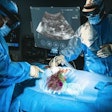Dear Advanced Visualization Insider,
The utility of body composition analysis of imaging studies in predicting a patient's future health risks has emerged as a hot research area in advanced visualization in recent years. And there was no shortage of presentations on these potentially lifesaving applications at RSNA 2021 in Chicago.
After utilizing an artificial intelligence (AI) model to analyze whole-body dual-energy x-ray absorptiometry (DEXA) exams, researchers found that biological age estimates produced by the model could be useful for predicting future risk of morbidity and all-cause mortality. Our coverage of the presentation is the subject of this edition's Insider Exclusive.
Another study also showed that changes in body composition over time can be identified on whole-body DEXA by AI algorithms, helping to predict mortality risk.
In addition, an automated pipeline could enable body composition analysis to be performed on chest CT exams. Also, volumetric assessment of bone mineral density on dual-energy CT exams can yield accurate predictions for future risk of osteoporosis-related fractures.
The potential for improved and faster image reconstruction from AI algorithms was also an active area at RSNA 2021. Spine MRI was a particularly popular application, with several different researchers describing the speed and image quality benefits from their respective algorithms.
One group found that neuroradiologists overwhelmingly preferred the image quality of the AI-reconstructed images to standard-of-care techniques, while another team reported that spine MRI reconstructed with a deep-learning algorithm significantly reduced exam time compared with conventional spine MRI and produced comparable image quality.
In other advanced visualization news, radiologists need to become familiar with techniques such as augmented reality (AR), according to a recent article. Patient-specific AR models can be useful in helping surgeons to plan urologic surgical procedures, and they can also help patients better understand their disease and treatment plan. In addition, virtual reality software can be utilized to quantify lung damage on the CT exams of COVID-19 patients.
Also, body composition analysis software that analyzes preoperative abdomen CT exams can opportunistically predict mortality in patients who have spine metastases. It can also assess CT lung cancer screening exams to identify patients at risk of death or hospitalization in the coming year.
Is there a story you'd like to see covered in the Advanced Visualization Community? Please feel free to drop me a line.
Happy holidays from all of us at AuntMinnie.com!




















